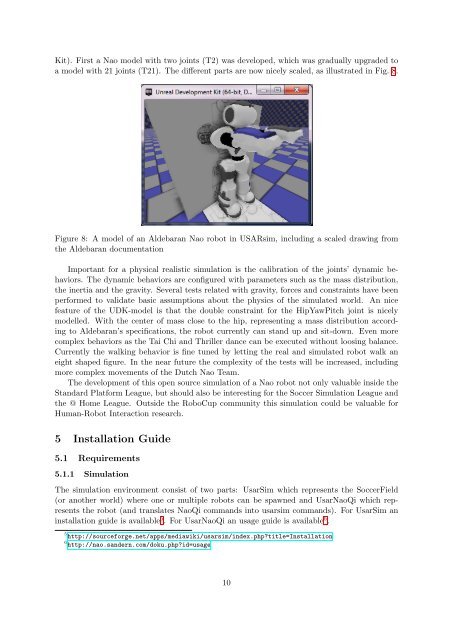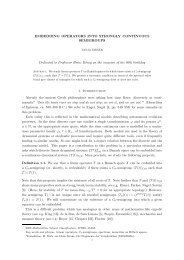Dutch Nao Team - Universiteit van Amsterdam
Dutch Nao Team - Universiteit van Amsterdam
Dutch Nao Team - Universiteit van Amsterdam
Create successful ePaper yourself
Turn your PDF publications into a flip-book with our unique Google optimized e-Paper software.
Kit). First a <strong>Nao</strong> model with two joints (T2) was developed, which was gradually upgraded to<br />
a model with 21 joints (T21). The different parts are now nicely scaled, as illustrated in Fig. 8.<br />
Figure 8: A model of an Aldebaran <strong>Nao</strong> robot in USARsim, including a scaled drawing from<br />
the Aldebaran documentation<br />
Important for a physical realistic simulation is the calibration of the joints’ dynamic behaviors.<br />
The dynamic behaviors are configured with parameters such as the mass distribution,<br />
the inertia and the gravity. Several tests related with gravity, forces and constraints have been<br />
performed to validate basic assumptions about the physics of the simulated world. An nice<br />
feature of the UDK-model is that the double constraint for the HipYawPitch joint is nicely<br />
modelled. With the center of mass close to the hip, representing a mass distribution according<br />
to Aldebaran’s specifications, the robot currently can stand up and sit-down. Even more<br />
complex behaviors as the Tai Chi and Thriller dance can be executed without loosing balance.<br />
Currently the walking behavior is fine tuned by letting the real and simulated robot walk an<br />
eight shaped figure. In the near future the complexity of the tests will be increased, including<br />
more complex movements of the <strong>Dutch</strong> <strong>Nao</strong> <strong>Team</strong>.<br />
The development of this open source simulation of a <strong>Nao</strong> robot not only valuable inside the<br />
Standard Platform League, but should also be interesting for the Soccer Simulation League and<br />
the @ Home League. Outside the RoboCup community this simulation could be valuable for<br />
Human-Robot Interaction research.<br />
5 Installation Guide<br />
5.1 Requirements<br />
5.1.1 Simulation<br />
The simulation environment consist of two parts: UsarSim which represents the SoccerField<br />
(or another world) where one or multiple robots can be spawned and Usar<strong>Nao</strong>Qi which represents<br />
the robot (and translates <strong>Nao</strong>Qi commands into usarsim commands). For UsarSim an<br />
installation guide is available 5 . For Usar<strong>Nao</strong>Qi an usage guide is available 6 .<br />
5 http://sourceforge.net/apps/mediawiki/usarsim/index.php?title=Installation<br />
6 http://nao.sandern.com/doku.php?id=usage<br />
10

















